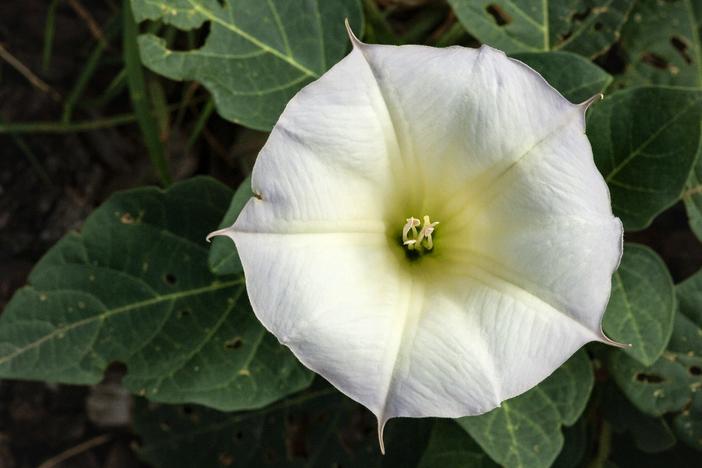Sacred Thorn-Apple
(Datura wrightii)
Sacred Thorn-Apple (Datura wrightii)
/
/

Cecelia Alexander
CC0 1.0
Image By:
Cecelia Alexander
Recorded By:
Copyright:
CC0 1.0
Copyright Notice:
Photo by: Cecelia Alexander | License Type: CC0 1.0 | License URL: https://creativecommons.org/publicdomain/zero/1.0/ | Uploader: aspidoscelis | Publisher: Flickr

























































































Estimated Native Range
Summary
Datura wrightii, commonly known as Sacred Thorn-Apple or Sacred Datura, is a herbaceous perennial native to open desert areas, riparian zones, and grasslands of the Southwestern USA and Northern Mexico. It typically grows 30 cm to 1.5 m in height and width, with a sprawling habit that can resemble a ground vine. The plant is notable for its large, sweetly fragrant white trumpet-shaped flowers, which can be up to 20 cm (7.9 in) long and are sometimes tinged with purple at the margins. These striking blooms appear from April through October, opening during cooler morning and evening hours and closing in the midday heat, or staying open longer during cloudy weather. The fruit is a spiny capsule, 3 to 4 cm in diameter, containing seeds that are dispersed when the capsule opens at maturity.
Sacred Datura is valued for its dramatic flowers and adaptability to harsh conditions, making it a popular choice for xeriscaping and ornamental use in arid landscapes. It thrives with minimal care, requiring low water once established and preferring well-drained soils. While it can tolerate full sun, it also does well in part shade. Gardeners should be cautious, as all parts of the plant are highly toxic if ingested. The plant’s toxicity, coupled with its vigorous growth, may pose a risk to humans and animals if not managed properly. Despite its beauty, Sacred Datura should be planted with care due to its poisonous nature and potential to spread in favorable conditions.CC BY-SA 4.0
Sacred Datura is valued for its dramatic flowers and adaptability to harsh conditions, making it a popular choice for xeriscaping and ornamental use in arid landscapes. It thrives with minimal care, requiring low water once established and preferring well-drained soils. While it can tolerate full sun, it also does well in part shade. Gardeners should be cautious, as all parts of the plant are highly toxic if ingested. The plant’s toxicity, coupled with its vigorous growth, may pose a risk to humans and animals if not managed properly. Despite its beauty, Sacred Datura should be planted with care due to its poisonous nature and potential to spread in favorable conditions.CC BY-SA 4.0
Plant Description
- Plant Type: Herb, Subshrub
- Height: 4-5 feet
- Width: 4-5 feet
- Growth Rate: Moderate
- Flower Color: Purple, White
- Flowering Season: Fall, Spring, Summer
- Leaf Retention: Deciduous
Growth Requirements
- Sun: Part Shade, Full Sun
- Water: Low
- Drainage: Fast
Common Uses
Bee Garden, Bird Garden, Deer Resistant, Drought Tolerant, Fragrant, Hummingbird Garden, Rabbit Resistant, Rock Garden, Showy Flowers
Natural Habitat
Native to open desert areas, riparian zones, and grasslands of the Southwestern USA and Northern Mexico
Other Names
Common Names: Sacred Datura, Sacred Thornapple, Hairy Thorn-Apple, Hoary Thorn-Apple, Recurved Thorn-Apple, Indianspikklubba
Scientific Names: , Datura wrightii, Datura lanosa, Datura innoxia subsp. quinquecuspidata, Datura innoxia subsp. quinquecuspida, Datura metel var. quinquecuspida, Datura innoxia var. quinquecuspidata, Datura metel var. quinquecuspidata,
GBIF Accepted Name: Datura wrightii hort. ex Regel